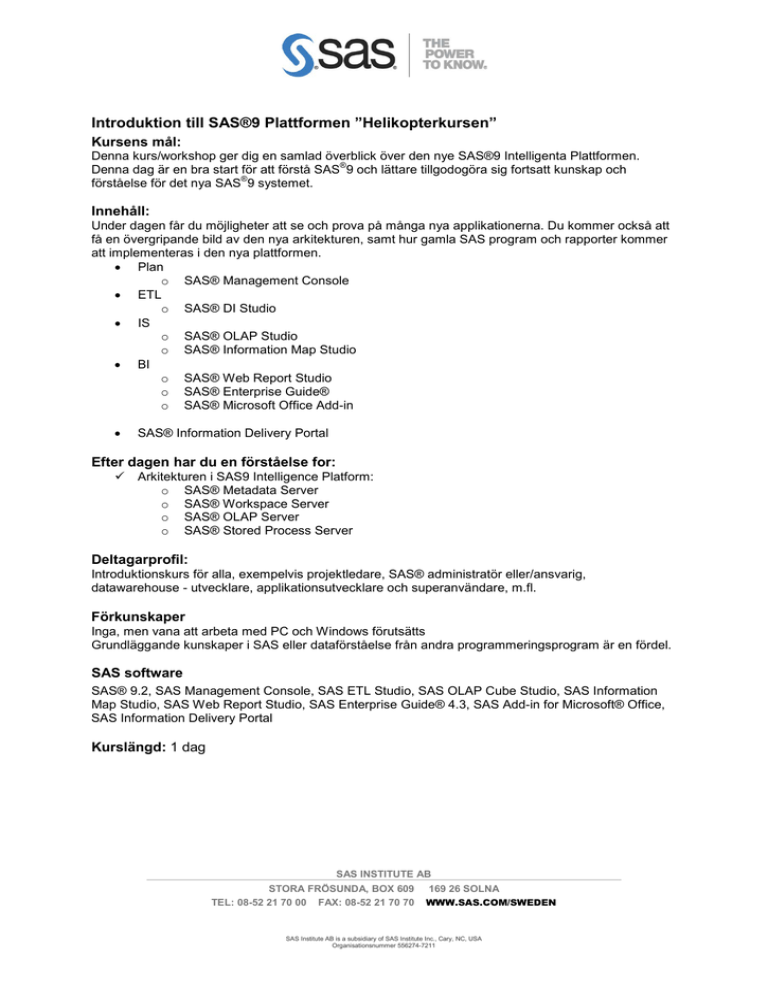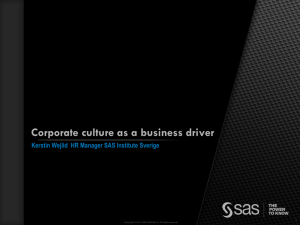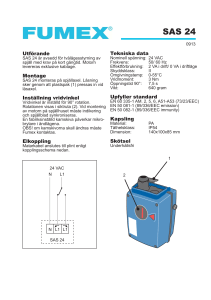Introduktion till SAS®9 Plattformen ”Helikopterkursen”
advertisement

Introduktion till SAS®9 Plattformen ”Helikopterkursen” Kursens mål: Denna kurs/workshop ger dig en samlad överblick över den nye SAS®9 Intelligenta Plattformen. ® Denna dag är en bra start för att förstå SAS 9 och lättare tillgodogöra sig fortsatt kunskap och ® förståelse för det nya SAS 9 systemet. Innehåll: Under dagen får du möjligheter att se och prova på många nya applikationerna. Du kommer också att få en övergripande bild av den nya arkitekturen, samt hur gamla SAS program och rapporter kommer att implementeras i den nya plattformen. • Plan o SAS® Management Console • ETL o SAS® DI Studio • IS o SAS® OLAP Studio o SAS® Information Map Studio • BI o SAS® Web Report Studio o SAS® Enterprise Guide® o SAS® Microsoft Office Add-in • SAS® Information Delivery Portal Efter dagen har du en förståelse for: Arkitekturen i SAS9 Intelligence Platform: o SAS® Metadata Server o SAS® Workspace Server o SAS® OLAP Server o SAS® Stored Process Server Deltagarprofil: Introduktionskurs för alla, exempelvis projektledare, SAS® administratör eller/ansvarig, datawarehouse - utvecklare, applikationsutvecklare och superanvändare, m.fl. Förkunskaper Inga, men vana att arbeta med PC och Windows förutsätts Grundläggande kunskaper i SAS eller dataförståelse från andra programmeringsprogram är en fördel. SAS software SAS® 9.2, SAS Management Console, SAS ETL Studio, SAS OLAP Cube Studio, SAS Information Map Studio, SAS Web Report Studio, SAS Enterprise Guide® 4.3, SAS Add-in for Microsoft® Office, SAS Information Delivery Portal Kurslängd: 1 dag SAS INSTITUTE AB STORA FRÖSUNDA, BOX 609 TEL: 08-52 21 70 00 FAX: 08-52 21 70 70 169 26 SOLNA WWW.SAS.COM/SWEDEN SAS Institute AB is a subsidiary of SAS Institute Inc., Cary, NC, USA Organisationsnummer 556274-7211 INTRODUCTION TO STATISTICS USING SAS® ENTERPRISE GUIDE® This two-day course gives an introduction to statistical analysis, and uses SAS Enterprise Guide as a tool to carry out these analyses. You learn how to explore and analyze your data to get more information and a better understanding of the data and what it represents. Who should attend: People that need statistic information from their data but doesn’t have any statistic knowledge Course Content: Introduction to statistics Basic statistical concepts • Descriptive statistics: *measures of location *measures of dispersion • Inferential statistics: *Hypothesis test Testing the population mean Comparing populations Testing proportions Chi square test *Correlation *Regression analysis Prerequisites: Before attending this course you should have a basic knowledge and experience using SAS Enterprise Guide. You should be able to add data, create queries and simple reports with SAS Enterprise Guide software. You can gain this experience by completing the Querying and Reporting Using SAS Enterprise Guide course. A prior knowledge about statistics is not required. This course is an introduction to statistics. Software Addressed: SAS Enterprise Guide 5.1 Duration: 2 days SAS INSTITUTE AB STORA FRÖSUNDA, BOX 609 TEL: 08-52 21 70 00 FAX: 08-52 21 70 70 169 26 SOLNA WWW.SAS.COM/SWEDEN SAS Institute AB is a subsidiary of SAS Institute Inc., Cary, NC, USA Organisationsnummer 556274-7211 SAS ENTERPRISE GUIDE 2: ADVANCED TASKS AND QUERYING This course is intended for experienced SAS Enterprise Guide users who want to learn more about advanced SAS Enterprise Guide techniques. It focuses on using the Query Builder within SAS Enterprise Guide, including manipulating character, numeric, and date values; converting variable type; and building conditional expressions using the Expression Builder. This course also addresses efficiency issues, such as joining tables and using a single query to group, summarize, and filter data. Course Content: • • • • • • • Introduction Using the Data Menu o introduction to data tasks o Split Columns task o Stack Columns task o Transpose task (self-study) o Random Sample task o Sort Data task Using Functions in the Query Builder o introduction to functions o manipulating values o converting data type Prompting and Conditional Processing o multiple values prompts o range prompts o conditional processing of project steps Case Logic o recoding values o using the Replace condition o writing CASE expressions o writing nested CASE expressions (self-study) Grouping and Filtering o grouping and summarizing data o including detail and summary data o filtering summarized data in groups Query Options (Self-Study) o Query output options Prerequisites: Before attending this course, students should understand how to navigate the SAS Enterprise Guide environment, create projects, add data sources, accomplish basic analysis and reporting using tasks, and create queries. You can gain this knowledge by taking the SAS Enterprise Guide 1: Querying and Reporting course or by completing the Getting Started tutorial in SAS Enterprise Guide. No SAS or SQL programming experience is required SAS software: Enterprise Guide 5.1 Duration: 1 day SAS INSTITUTE AB STORA FRÖSUNDA, BOX 609 TEL: 08-52 21 70 00 FAX: 08-52 21 70 70 169 26 SOLNA WWW.SAS.COM/SWEDEN SAS Institute AB is a subsidiary of SAS Institute Inc., Cary, NC, USA Organisationsnummer 556274-7211 SAS MACRO LANGUAGE 2: ADVANCED TECHNIQUES This course covers macro quoting functions, macro storage, and macro techniques for advanced data access, table lookup operations, advanced parameter validation, and macro windows. Learn how to: • use the stored compiled and autocall macro facilities • write data-driven macro calls • use the CALL EXECUTE statement • exploit SAS I/O and external file functions • create user-written macro functions • automate importing CSV, Excel, and Microsoft Access files • validate user input • implement table lookup techniques • create macro windows. Course Content: • Macro Storage • Protecting Special Characters • Reading Sas Data • Reading External Data • Table Lookup Techniques • Validating User Input Prerequisites: In order to be successful in this course, you should have completed the SAS Macro Language 1: Essentials course or have equivalent knowledge and experience. Specifically, you should be able to • • • • • write macro programs that contain iterative processing and conditional processing create local and global macro variables create macro variables using the SYMPUTX routine utilize indirect macro variable references utilize the SQL procedure SELECT statement INTO clause. SAS software: Base SAS Software Duration: 2 days SAS INSTITUTE AB STORA FRÖSUNDA, BOX 609 TEL: 08-52 21 70 00 FAX: 08-52 21 70 70 169 26 SOLNA WWW.SAS.COM/SWEDEN SAS Institute AB is a subsidiary of SAS Institute Inc., Cary, NC, USA Organisationsnummer 556274-7211 SAS SQL 2 In this course, students learn advanced techniques for processing data using Structured Query Language (SQL), explore issues that can degrade SQL query performance, and gain hands-on experience in tuning SQL queries and databases. • efficiently query and manage data stored in SAS and in relational database management system (RDBMS) tables • improve the efficiency of complex SQL joins • apply advanced techniques to o summarize and present data o update a table using data from another table • identify when an index can improve query performance • create and exploit effective indexes • use integrity constraints to enforce business rules in tables • use the SAS macro facility and the SQL procedure to generate data-driven complex SQL queries. Course Content: • Accessing Relational Database Management Data • SQL Query Optimization • Subqueries • SQL Join Techniques • Data Management • Advanced Techniques Prerequisites: This course is not appropriate for beginning SAS or SQL software users. Before attending this course, you should have a minimum of six months of SAS and SQL programming experience and should have completed the SAS SQL 1: Essentials course. Prior to attending this course, you should know how to • submit SAS programs • create and access SAS data sets • access existing SAS and RDBMS data using the LIBNAME statement • use arithmetic, comparison, and logical operators • use the SQL procedure to • o query and subset data o create views, indexes, and tables o retrieve and combine data from multiple tables, including complex joins and merges o update or delete values in existing tables or views use the SAS macro facility to create and retrieve macro variables. SAS software: Base SAS Software Duration: 2 days SAS INSTITUTE AB STORA FRÖSUNDA, BOX 609 TEL: 08-52 21 70 00 FAX: 08-52 21 70 70 169 26 SOLNA WWW.SAS.COM/SWEDEN SAS Institute AB is a subsidiary of SAS Institute Inc., Cary, NC, USA Organisationsnummer 556274-7211

